Abstract
Purpose
Previous studies have indicated that transient receptor potential (TRP) channels can influence cancer development. The TRPC subfamily consists of seven subtypes, TRPC1 − TRPC7. Interestingly, the expression levels of TRPC1 have been shown to be totally different in different breast cancer cell lines. Nevertheless, the underlying mechanism remains unknown. In this study, we explore the significance of TRPC1 expression in breast cancer.
Methods
Immunohistochemical TRPC1 staining was performed in 278 samples. TRPC1 expression in different breast tissues were examined. Then, the influence of TRPC1 on migration, invasion and proliferation was explored. We analyzed the protein of TRPC1 by Western blot to prove which pathway may be involved in. Finally, we use online database to predict the prognosis of TRPC1 in breast cancer.
Results
Through immunohistochemistry and in vitro experiments, we found that the expression level of TRPC1 was higher in breast cancer cells as compared with that in normal breast epithelial cells. Moreover, the expression level of TRPC1 was different between estrogen receptor-positive (ER +) and -negative (ER −) breast cancer. It was shown that TRPC1 inhibited MCF7 cell proliferation, migration, and invasion in vitro. Western blotting revealed that TRPC1 inhibited the PI3K/AKT pathway and epithelium−mesenchymal transformation, leading to subsequent inhibition of cell proliferation and metastasis. In luminal A and luminal B patients, those with high TRPC1 expression had a better prognosis. On the contrary, in basal-like and triple-negative breast cancer (TNBC) subtypes, patients with high-TRPC1 expression had a worse prognosis.
Conclusions
We confirmed that TRPC1 was high expression in breast cancer. Overexpression of TRPC1 inhibits proliferation and migration of ER + breast cancer and gives a better prognosis by inhibiting PI3K/AKT pathway activation. TRPC1 may be an independent prognostic predictor in breast cancer patients.







Similar content being viewed by others
References
Lafourcade A et al (2018) Factors associated with breast cancer recurrences or mortality and dynamic prediction of death using history of cancer recurrences: the French E3N cohort. BMC Cancer 18(1):171
Alwan NAS et al (2017) Clinical and pathological characteristics of triple positive breast cancer among Iraqi patients. Gulf J Oncol 1(25):51–60
Benemei S et al (2015) TRP channels. Curr Opin Pharmacol 22:18–23
Bodding M (2007) TRP proteins and cancer. Cell Signal 19(3):617–624
Beech DJ, Muraki K, Flemming R (2004) Non-selective cationic channels of smooth muscle and the mammalian homologues of Drosophila TRP. J Physiol 559(Pt 3):685–706
Belkacemi T et al (2017) TRPC1- and TRPC3-dependent Ca(2+) signaling in mouse cortical astrocytes affects injury-evoked astrogliosis in vivo. Glia 65(9):1535–1549
Broker-Lai J et al (2017) Heteromeric channels formed by TRPC1, TRPC4 and TRPC5 define hippocampal synaptic transmission and working memory. EMBO J 36(18):2770–2789
Dart C et al (1998) The dependence of Ag+ block of a potassium channel, murine kir2.1, on a cysteine residue in the selectivity filter. J Physiol 511(Pt 1):15–24
Delmas P et al (2002) Signaling microdomains define the specificity of receptor-mediated InsP(3) pathways in neurons. Neuron 34(2):209–220
Dietrich A, Fahlbusch M, Gudermann T (2014) Classical transient receptor potential 1 (TRPC1): channel or channel regulator? Cells 3(4):939–962
Smyth JT et al (2010) Activation and regulation of store-operated calcium entry. J Cell Mol Med 14(10):2337–2349
Huang GN et al (2006) STIM1 carboxyl-terminus activates native SOC, I(crac) and TRPC1 channels. Nat Cell Biol 8(9):1003–1010
Rao JN et al (2006) TRPC1 functions as a store-operated Ca2+ channel in intestinal epithelial cells and regulates early mucosal restitution after wounding. Am J Physiol Gastrointest Liver Physiol 290(4):G782–G792
Inkins WG, Estacion M, Schilling WP (1998) Functional expression of TrpC1: a human homologue of the Drosophila Trp channel. Biochem J 331(Pt 1):331–339
Sours S et al (2006) Expression of canonical transient receptor potential (TRPC) proteins in human glomerular mesangial cells. Am J Physiol Renal Physiol 290(6):F1507–F1515
Yuan JP et al (2003) Homer binds TRPC family channels and is required for gating of TRPC1 by IP3 receptors. Cell 114(6):777–789
Zitt C et al (1996) Cloning and functional expression of a human Ca2+-permeable cation channel activated by calcium store depletion. Neuron 16(6):1189–1196
Kania E, Pajak B, Orzechowski A (2015) Calcium homeostasis and ER stress in control of autophagy in cancer cells. Biomed Res Int 2015:352794
Berridge MJ, Lipp P, Bootman MD (2000) The versatility and universality of calcium signalling. Nat Rev Mol Cell Biol 1(1):11–21
Pettit EJ, Fay FS (1998) Cytosolic free calcium and the cytoskeleton in the control of leukocyte chemotaxis. Physiol Rev 78(4):949–967
Ge P et al (2018) TRPC1/3/6 inhibition attenuates the TGF-beta1-induced epithelial-mesenchymal transition in gastric cancer via the Ras/Raf1/ERK signaling pathway. Cell Biol Int 42(8):975–984
Davis FM et al (2012) Non-stimulated, agonist-stimulated and store-operated Ca2+ influx in MDA-MB-468 breast cancer cells and the effect of EGF-induced EMT on calcium entry. PLoS ONE 7(5):e36923
Ouadid-Ahidouch H et al (2012) TRP calcium channel and breast cancer: expression, role and correlation with clinical parameters. Bull Cancer 99(6):655–664
Philip D, Poorvu M (2019) Prognostic impact of the 21-Gene Recurrence Score Assay Among Young Women With Node-Negative And Node-Positive ER-positive/ HER2-negative breast cancer. J Clin Oncol 38:725
Hammond ME et al (2010) American society of clinical oncology/college of american pathologists guideline recommendations for immunohistochemical testing of estrogen and progesterone receptors in breast cancer. J Oncol Pract 6(4):195–197
Hanna WM et al (2017) Comparative analysis of human epidermal growth factor receptor 2 testing in breast cancer according to 2007 and 2013 American Society of Clinical Oncology/College of American Pathologists Guideline Recommendations. J Clin Oncol 35(26):3039–3045
Goldhirsch A et al (2013) Personalizing the treatment of women with early breast cancer: highlights of the St Gallen International Expert Consensus on the Primary Therapy of Early Breast Cancer 2013. Ann Oncol 24(9):2206–2223
Azimi I et al (2017) TRPC1 is a differential regulator of hypoxia-mediated events and Akt signalling in PTEN-deficient breast cancer cells. J Cell Sci 130(14):2292–2305
Weber LV et al (2016) Expression and functionality of TRPV1 in breast cancer cells. Breast Cancer (Dove Med Press) 8:243–252
Venkatachalam K, Zheng F, Gill DL (2003) Regulation of canonical transient receptor potential (TRPC) channel function by diacylglycerol and protein kinase C. J Biol Chem 278(31):29031–29040
Putney JW Jr et al (2001) Mechanisms of capacitative calcium entry. J Cell Sci 114(Pt 12):2223–2229
McCarl CA et al (2010) Store-operated Ca2+ entry through ORAI1 is critical for T cell-mediated autoimmunity and allograft rejection. J Immunol 185(10):5845–5858
Motiani RK, Abdullaev IF, Trebak M (2010) A novel native store-operated calcium channel encoded by Orai3: selective requirement of Orai3 versus Orai1 in estrogen receptor-positive versus estrogen receptor-negative breast cancer cells. J Biol Chem 285(25):19173–19183
McAndrew D et al (2011) ORAI1-mediated calcium influx in lactation and in breast cancer. Mol Cancer Ther 10(3):448–460
Chen YF et al (2011) Calcium store sensor stromal-interaction molecule 1-dependent signaling plays an important role in cervical cancer growth, migration, and angiogenesis. Proc Natl Acad Sci USA 108(37):15225–15230
Li G et al (2013) Suppression of STIM1 inhibits human glioblastoma cell proliferation and induces G0/G1 phase arrest. J Exp Clin Cancer Res 32:20
Umemura M et al (2014) Store-operated Ca2+ entry (SOCE) regulates melanoma proliferation and cell migration. PLoS ONE 9(2):e89292
Wang JY et al (2015) STIM1 overexpression promotes colorectal cancer progression, cell motility and COX-2 expression. Oncogene 34(33):4358–4367
Yang S, Zhang JJ, Huang XY (2009) Orai1 and STIM1 are critical for breast tumor cell migration and metastasis. Cancer Cell 15(2):124–134
Li S et al (2019) Inhibition of MCF-7 breast cancer cell proliferation by a synthetic peptide derived from the C-terminal sequence of Orai channel. Biochem Biophys Res Commun 516(4):1066–1072
Perrouin Verbe MA et al (2016) Expression of store-operated channel components in prostate cancer: the prognostic paradox. Hum Pathol 49:77–82
Lee WH et al (2017) TRPV4 plays a role in breast cancer cell migration via Ca(2+)-dependent activation of AKT and downregulation of E-cadherin cell cortex protein. Oncogenesis 6(5):e338
Funding
This work partly supported by the funds from National Natural Science Foundation of China [NO.81602345 (Yong-Qu Zhang)], Science and Technology Planning Project of Guangdong Province, China [NO.2016A020215145 (Xiao-Long Wei)], Science and Technology Planning Project of Shantou, China [NO.190917085269842 (Xiao-Long Wei)], Science and Technology Planning Project of Shantou, China [NO.(2019)62 (Yun-Zhu Zeng)].
Author information
Authors and Affiliations
Corresponding authors
Ethics declarations
Conflict of interest
The authors declare that they have no competing interests.
Ethical approval
The work was conducted in accordance with the Declaration of Helsinki. The study was approved by Medical Ethics Committee of the Cancer Hospital of Shantou University Medical College.
Informed consent
This article does not contain any studies with human participants or animals. The entire study protocol was approved by the Medical Ethical Committee of the Cancer Hospital of Shantou University Medical College. The need for obtaining informed consent was waived by this committee.
Additional information
Publisher's Note
Springer Nature remains neutral with regard to jurisdictional claims in published maps and institutional affiliations.
Rights and permissions
About this article
Cite this article
Zhang, LY., Zhang, YQ., Zeng, YZ. et al. TRPC1 inhibits the proliferation and migration of estrogen receptor-positive Breast cancer and gives a better prognosis by inhibiting the PI3K/AKT pathway. Breast Cancer Res Treat 182, 21–33 (2020). https://doi.org/10.1007/s10549-020-05673-8
Received:
Accepted:
Published:
Issue Date:
DOI: https://doi.org/10.1007/s10549-020-05673-8




